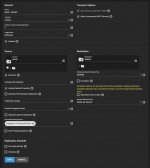Fire-Dragon-DoL
Contributor
- Joined
- Dec 22, 2018
- Messages
- 103
Hi everybody,
I have a pool with mirroring, so 1 drive is fully replicated on the other. While this is not a backup, it helps with availability.
I also run backups every 2 months, I do this by manually connecting the HDD (giant pain because I have to put screws and move stuff), plug it in, then I use "Replication" in the UI to perform what I would consider a backup. (see the config in attached files)
Or at least that's what I thought "Replication" would do.
- One time I performed a "sample test" and discovered missing files
- Now since I don't trust my backup mechanisms anymore, I used zfs-check and discovered missing files
- I also discovered _excessive files_, files that shouldn't be there but are
What are my options for:
- Performing a backup, the easiest way. Destination HDD should become "same" as Source HDD (non-existing files on source should be deleted from right, new/updated files should be copied over), if possible I'd like all snapshots to also be copied, so that the state are similar
- Avoid having to perform a full rewrite of the HDDs
- Sometimes pruning snapshots before a certain date on both source and destination
- Testing that the backup worked. Is zfs-check a reasonable tool? Should I use rsync instead?
I'd appreciate some help, since not trusting my own backups is scary.
I have a pool with mirroring, so 1 drive is fully replicated on the other. While this is not a backup, it helps with availability.
I also run backups every 2 months, I do this by manually connecting the HDD (giant pain because I have to put screws and move stuff), plug it in, then I use "Replication" in the UI to perform what I would consider a backup. (see the config in attached files)
Or at least that's what I thought "Replication" would do.
- One time I performed a "sample test" and discovered missing files
- Now since I don't trust my backup mechanisms anymore, I used zfs-check and discovered missing files
- I also discovered _excessive files_, files that shouldn't be there but are
What are my options for:
- Performing a backup, the easiest way. Destination HDD should become "same" as Source HDD (non-existing files on source should be deleted from right, new/updated files should be copied over), if possible I'd like all snapshots to also be copied, so that the state are similar
- Avoid having to perform a full rewrite of the HDDs
- Sometimes pruning snapshots before a certain date on both source and destination
- Testing that the backup worked. Is zfs-check a reasonable tool? Should I use rsync instead?
I'd appreciate some help, since not trusting my own backups is scary.

